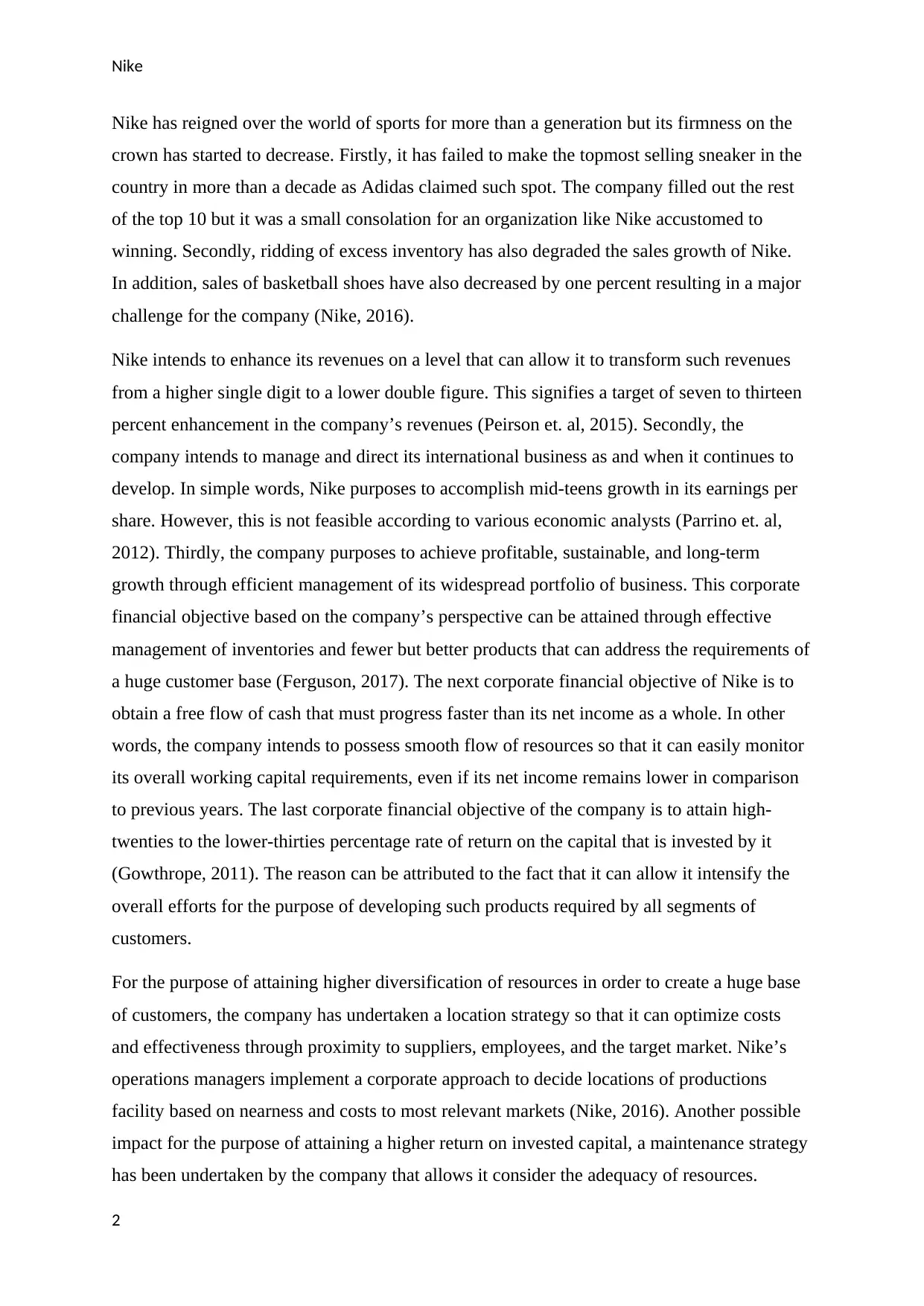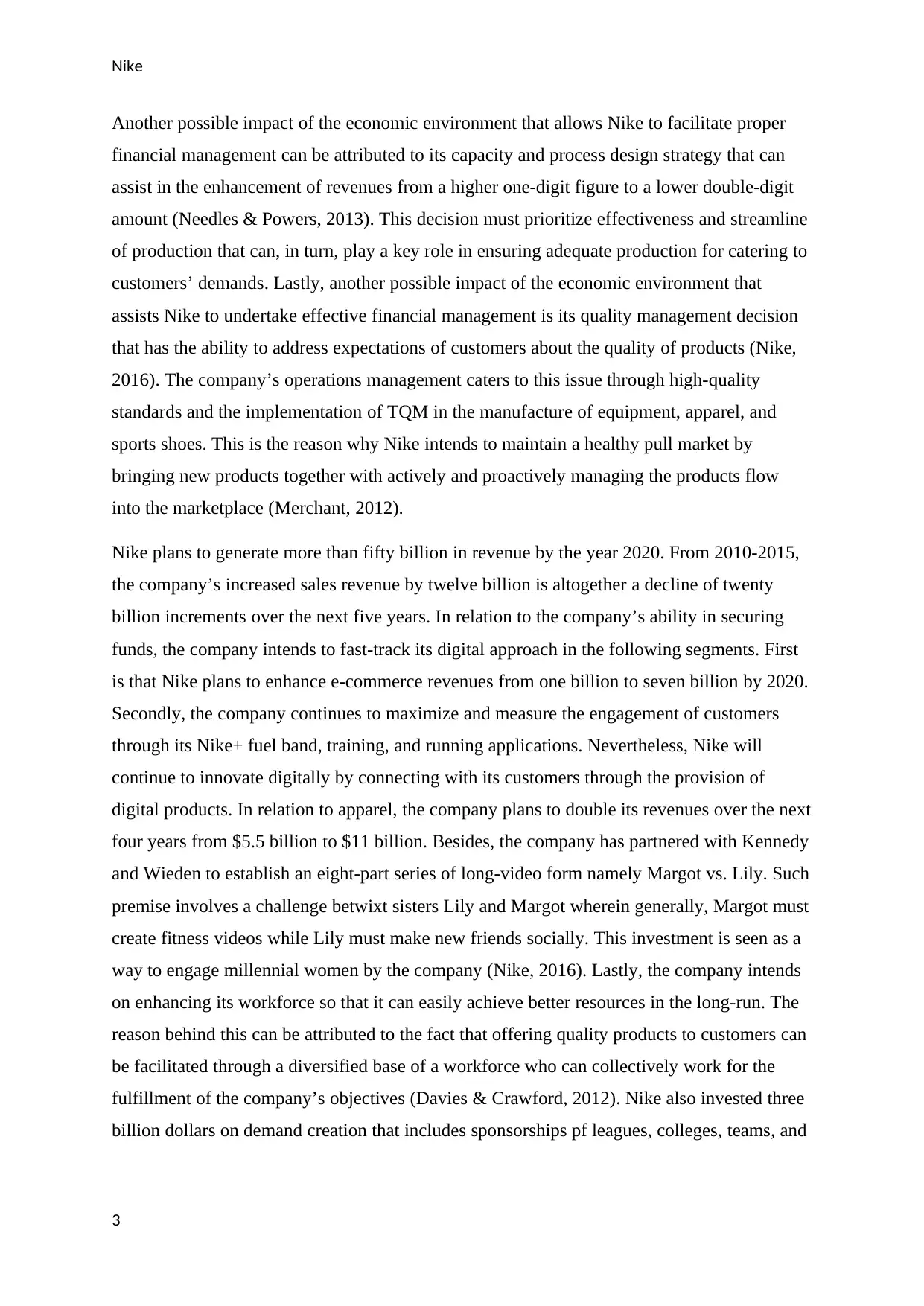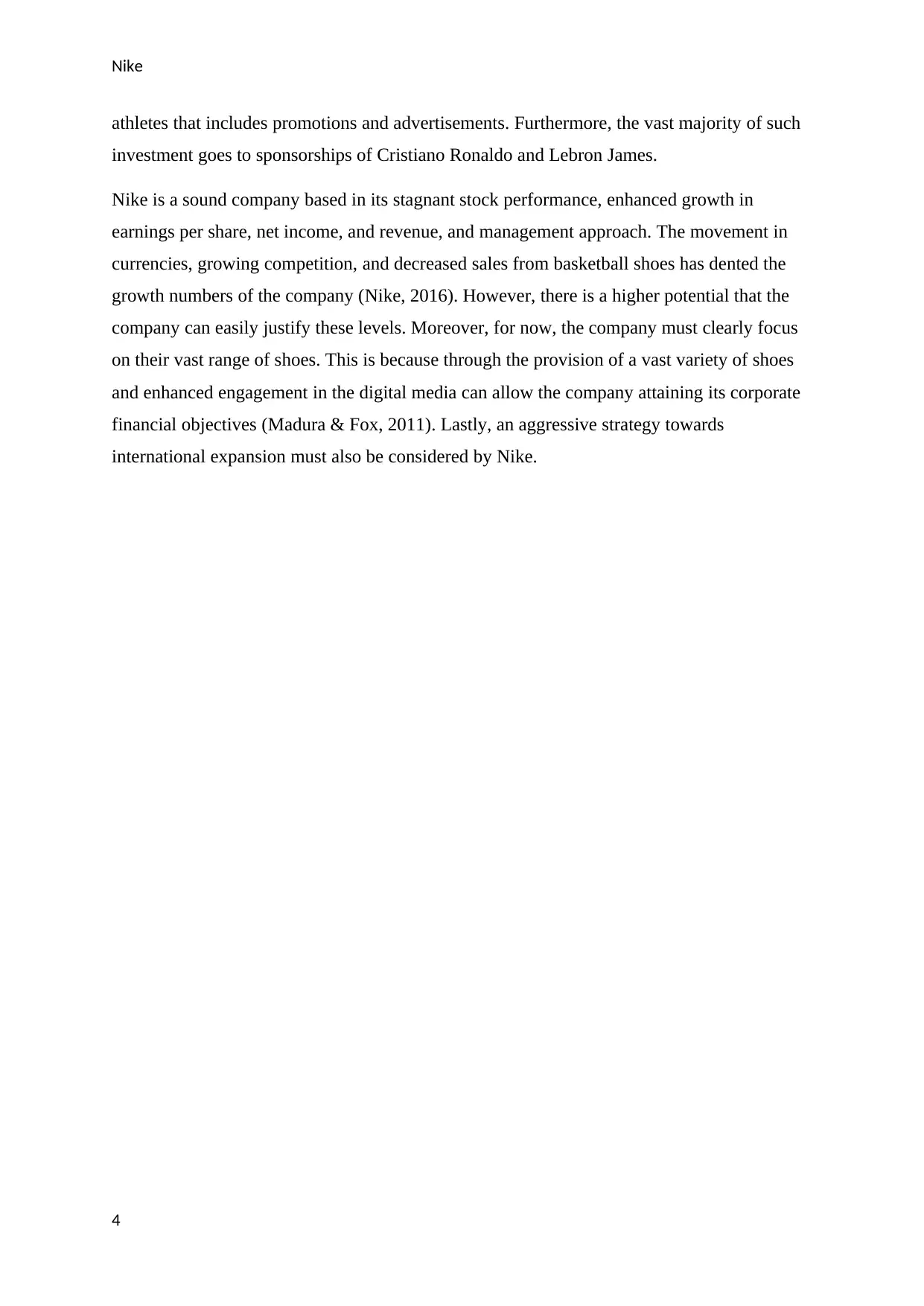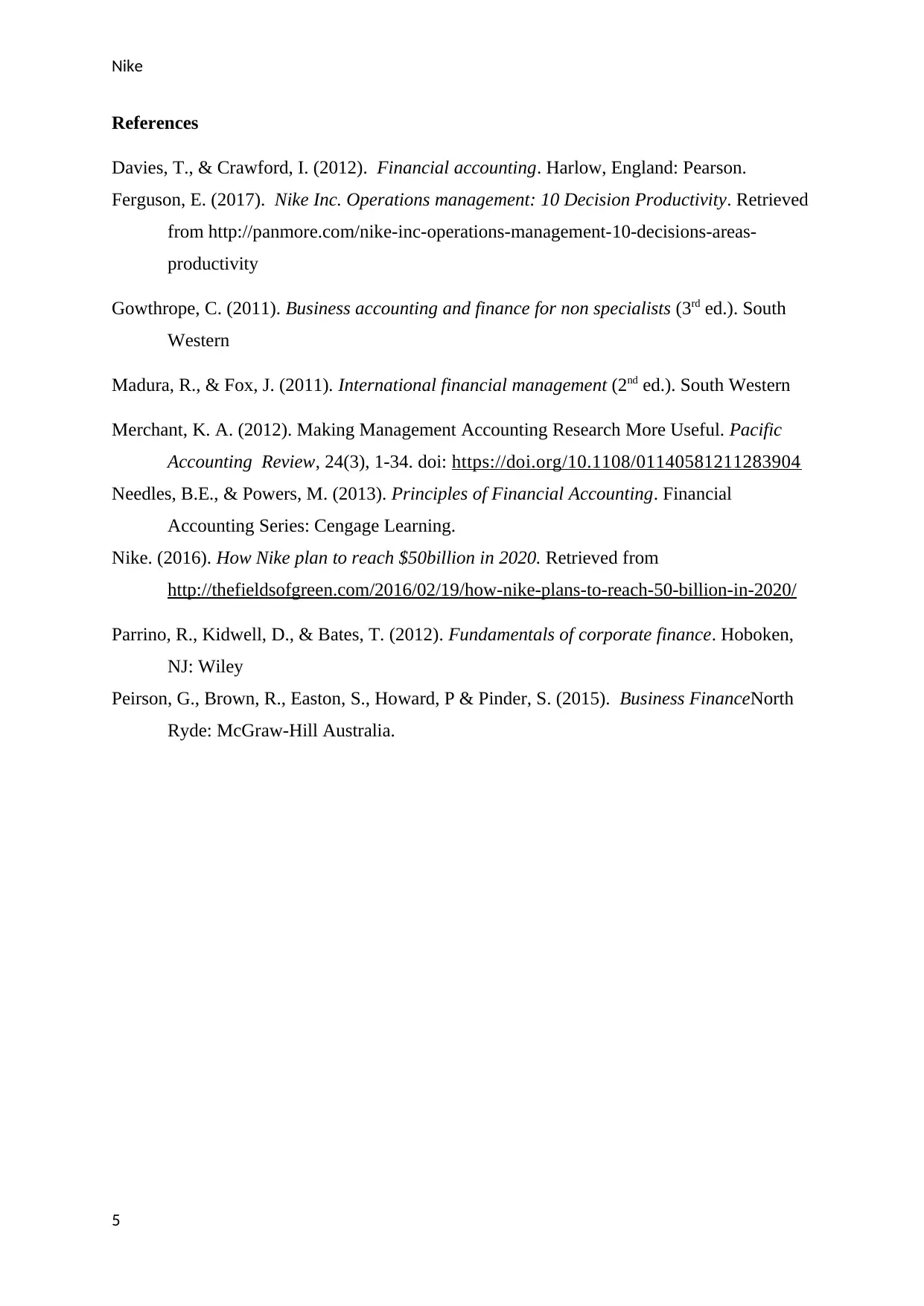Financial Management Case Study: Nike's Objectives and Strategies
VerifiedAdded on 2023/06/13
|5
|1442
|406
Case Study
AI Summary
This case study examines Nike's financial management strategies, objectives, and the impact of the economic environment on its performance. It highlights Nike's revenue enhancement goals, international business management, and commitment to sustainable growth. The analysis covers Nike's location, maintenance, capacity, and quality management decisions, emphasizing their role in achieving financial objectives. The case study also discusses Nike's plans for digital expansion, apparel revenue doubling, and workforce enhancement, alongside significant investments in demand creation through sponsorships. Ultimately, it assesses Nike's strengths, challenges, and potential strategies for future growth, including a focus on diverse product offerings, digital media engagement, and international expansion, recommending that these approaches will support the company in attaining its corporate financial objectives.

qwertyuiopasdfghjklzxcvbnmqw
ertyuiopasdfghjklzxcvbnmqwert
yuiopasdfghjklzxcvbnmqwertyui
opasdfghjklzxcvbnmqwertyuiopa
sdfghjklzxcvbnmqwertyuiopasdf
ghjklzxcvbnmqwertyuiopasdfghj
klzxcvbnmqwertyuiopasdfghjklz
xcvbnmqwertyuiopasdfghjklzxcv
bnmqwertyuiopasdfghjklzxcvbn
mqwertyuiopasdfghjklzxcvbnmq
wertyuiopasdfghjklzxcvbnmqwer
tyuiopasdfghjklzxcvbnmqwertyui
opasdfghjklzxcvbnmqwertyuiopa
sdfghjklzxcvbnmqwertyuiopasdf
ghjklzxcvbnmqwertyuiopasdfghj
klzxcvbnmqwertyuiopasdfghjklz
xcvbnmrtyuiopasdfghjklzxcvbnm
qwertyuiopasdfghjklzxcvbnmqw
FINANCIAL MANAGEMENT
ertyuiopasdfghjklzxcvbnmqwert
yuiopasdfghjklzxcvbnmqwertyui
opasdfghjklzxcvbnmqwertyuiopa
sdfghjklzxcvbnmqwertyuiopasdf
ghjklzxcvbnmqwertyuiopasdfghj
klzxcvbnmqwertyuiopasdfghjklz
xcvbnmqwertyuiopasdfghjklzxcv
bnmqwertyuiopasdfghjklzxcvbn
mqwertyuiopasdfghjklzxcvbnmq
wertyuiopasdfghjklzxcvbnmqwer
tyuiopasdfghjklzxcvbnmqwertyui
opasdfghjklzxcvbnmqwertyuiopa
sdfghjklzxcvbnmqwertyuiopasdf
ghjklzxcvbnmqwertyuiopasdfghj
klzxcvbnmqwertyuiopasdfghjklz
xcvbnmrtyuiopasdfghjklzxcvbnm
qwertyuiopasdfghjklzxcvbnmqw
FINANCIAL MANAGEMENT
Paraphrase This Document
Need a fresh take? Get an instant paraphrase of this document with our AI Paraphraser

Nike
Nike has reigned over the world of sports for more than a generation but its firmness on the
crown has started to decrease. Firstly, it has failed to make the topmost selling sneaker in the
country in more than a decade as Adidas claimed such spot. The company filled out the rest
of the top 10 but it was a small consolation for an organization like Nike accustomed to
winning. Secondly, ridding of excess inventory has also degraded the sales growth of Nike.
In addition, sales of basketball shoes have also decreased by one percent resulting in a major
challenge for the company (Nike, 2016).
Nike intends to enhance its revenues on a level that can allow it to transform such revenues
from a higher single digit to a lower double figure. This signifies a target of seven to thirteen
percent enhancement in the company’s revenues (Peirson et. al, 2015). Secondly, the
company intends to manage and direct its international business as and when it continues to
develop. In simple words, Nike purposes to accomplish mid-teens growth in its earnings per
share. However, this is not feasible according to various economic analysts (Parrino et. al,
2012). Thirdly, the company purposes to achieve profitable, sustainable, and long-term
growth through efficient management of its widespread portfolio of business. This corporate
financial objective based on the company’s perspective can be attained through effective
management of inventories and fewer but better products that can address the requirements of
a huge customer base (Ferguson, 2017). The next corporate financial objective of Nike is to
obtain a free flow of cash that must progress faster than its net income as a whole. In other
words, the company intends to possess smooth flow of resources so that it can easily monitor
its overall working capital requirements, even if its net income remains lower in comparison
to previous years. The last corporate financial objective of the company is to attain high-
twenties to the lower-thirties percentage rate of return on the capital that is invested by it
(Gowthrope, 2011). The reason can be attributed to the fact that it can allow it intensify the
overall efforts for the purpose of developing such products required by all segments of
customers.
For the purpose of attaining higher diversification of resources in order to create a huge base
of customers, the company has undertaken a location strategy so that it can optimize costs
and effectiveness through proximity to suppliers, employees, and the target market. Nike’s
operations managers implement a corporate approach to decide locations of productions
facility based on nearness and costs to most relevant markets (Nike, 2016). Another possible
impact for the purpose of attaining a higher return on invested capital, a maintenance strategy
has been undertaken by the company that allows it consider the adequacy of resources.
2
Nike has reigned over the world of sports for more than a generation but its firmness on the
crown has started to decrease. Firstly, it has failed to make the topmost selling sneaker in the
country in more than a decade as Adidas claimed such spot. The company filled out the rest
of the top 10 but it was a small consolation for an organization like Nike accustomed to
winning. Secondly, ridding of excess inventory has also degraded the sales growth of Nike.
In addition, sales of basketball shoes have also decreased by one percent resulting in a major
challenge for the company (Nike, 2016).
Nike intends to enhance its revenues on a level that can allow it to transform such revenues
from a higher single digit to a lower double figure. This signifies a target of seven to thirteen
percent enhancement in the company’s revenues (Peirson et. al, 2015). Secondly, the
company intends to manage and direct its international business as and when it continues to
develop. In simple words, Nike purposes to accomplish mid-teens growth in its earnings per
share. However, this is not feasible according to various economic analysts (Parrino et. al,
2012). Thirdly, the company purposes to achieve profitable, sustainable, and long-term
growth through efficient management of its widespread portfolio of business. This corporate
financial objective based on the company’s perspective can be attained through effective
management of inventories and fewer but better products that can address the requirements of
a huge customer base (Ferguson, 2017). The next corporate financial objective of Nike is to
obtain a free flow of cash that must progress faster than its net income as a whole. In other
words, the company intends to possess smooth flow of resources so that it can easily monitor
its overall working capital requirements, even if its net income remains lower in comparison
to previous years. The last corporate financial objective of the company is to attain high-
twenties to the lower-thirties percentage rate of return on the capital that is invested by it
(Gowthrope, 2011). The reason can be attributed to the fact that it can allow it intensify the
overall efforts for the purpose of developing such products required by all segments of
customers.
For the purpose of attaining higher diversification of resources in order to create a huge base
of customers, the company has undertaken a location strategy so that it can optimize costs
and effectiveness through proximity to suppliers, employees, and the target market. Nike’s
operations managers implement a corporate approach to decide locations of productions
facility based on nearness and costs to most relevant markets (Nike, 2016). Another possible
impact for the purpose of attaining a higher return on invested capital, a maintenance strategy
has been undertaken by the company that allows it consider the adequacy of resources.
2

Nike
Another possible impact of the economic environment that allows Nike to facilitate proper
financial management can be attributed to its capacity and process design strategy that can
assist in the enhancement of revenues from a higher one-digit figure to a lower double-digit
amount (Needles & Powers, 2013). This decision must prioritize effectiveness and streamline
of production that can, in turn, play a key role in ensuring adequate production for catering to
customers’ demands. Lastly, another possible impact of the economic environment that
assists Nike to undertake effective financial management is its quality management decision
that has the ability to address expectations of customers about the quality of products (Nike,
2016). The company’s operations management caters to this issue through high-quality
standards and the implementation of TQM in the manufacture of equipment, apparel, and
sports shoes. This is the reason why Nike intends to maintain a healthy pull market by
bringing new products together with actively and proactively managing the products flow
into the marketplace (Merchant, 2012).
Nike plans to generate more than fifty billion in revenue by the year 2020. From 2010-2015,
the company’s increased sales revenue by twelve billion is altogether a decline of twenty
billion increments over the next five years. In relation to the company’s ability in securing
funds, the company intends to fast-track its digital approach in the following segments. First
is that Nike plans to enhance e-commerce revenues from one billion to seven billion by 2020.
Secondly, the company continues to maximize and measure the engagement of customers
through its Nike+ fuel band, training, and running applications. Nevertheless, Nike will
continue to innovate digitally by connecting with its customers through the provision of
digital products. In relation to apparel, the company plans to double its revenues over the next
four years from $5.5 billion to $11 billion. Besides, the company has partnered with Kennedy
and Wieden to establish an eight-part series of long-video form namely Margot vs. Lily. Such
premise involves a challenge betwixt sisters Lily and Margot wherein generally, Margot must
create fitness videos while Lily must make new friends socially. This investment is seen as a
way to engage millennial women by the company (Nike, 2016). Lastly, the company intends
on enhancing its workforce so that it can easily achieve better resources in the long-run. The
reason behind this can be attributed to the fact that offering quality products to customers can
be facilitated through a diversified base of a workforce who can collectively work for the
fulfillment of the company’s objectives (Davies & Crawford, 2012). Nike also invested three
billion dollars on demand creation that includes sponsorships pf leagues, colleges, teams, and
3
Another possible impact of the economic environment that allows Nike to facilitate proper
financial management can be attributed to its capacity and process design strategy that can
assist in the enhancement of revenues from a higher one-digit figure to a lower double-digit
amount (Needles & Powers, 2013). This decision must prioritize effectiveness and streamline
of production that can, in turn, play a key role in ensuring adequate production for catering to
customers’ demands. Lastly, another possible impact of the economic environment that
assists Nike to undertake effective financial management is its quality management decision
that has the ability to address expectations of customers about the quality of products (Nike,
2016). The company’s operations management caters to this issue through high-quality
standards and the implementation of TQM in the manufacture of equipment, apparel, and
sports shoes. This is the reason why Nike intends to maintain a healthy pull market by
bringing new products together with actively and proactively managing the products flow
into the marketplace (Merchant, 2012).
Nike plans to generate more than fifty billion in revenue by the year 2020. From 2010-2015,
the company’s increased sales revenue by twelve billion is altogether a decline of twenty
billion increments over the next five years. In relation to the company’s ability in securing
funds, the company intends to fast-track its digital approach in the following segments. First
is that Nike plans to enhance e-commerce revenues from one billion to seven billion by 2020.
Secondly, the company continues to maximize and measure the engagement of customers
through its Nike+ fuel band, training, and running applications. Nevertheless, Nike will
continue to innovate digitally by connecting with its customers through the provision of
digital products. In relation to apparel, the company plans to double its revenues over the next
four years from $5.5 billion to $11 billion. Besides, the company has partnered with Kennedy
and Wieden to establish an eight-part series of long-video form namely Margot vs. Lily. Such
premise involves a challenge betwixt sisters Lily and Margot wherein generally, Margot must
create fitness videos while Lily must make new friends socially. This investment is seen as a
way to engage millennial women by the company (Nike, 2016). Lastly, the company intends
on enhancing its workforce so that it can easily achieve better resources in the long-run. The
reason behind this can be attributed to the fact that offering quality products to customers can
be facilitated through a diversified base of a workforce who can collectively work for the
fulfillment of the company’s objectives (Davies & Crawford, 2012). Nike also invested three
billion dollars on demand creation that includes sponsorships pf leagues, colleges, teams, and
3
⊘ This is a preview!⊘
Do you want full access?
Subscribe today to unlock all pages.

Trusted by 1+ million students worldwide

Nike
athletes that includes promotions and advertisements. Furthermore, the vast majority of such
investment goes to sponsorships of Cristiano Ronaldo and Lebron James.
Nike is a sound company based in its stagnant stock performance, enhanced growth in
earnings per share, net income, and revenue, and management approach. The movement in
currencies, growing competition, and decreased sales from basketball shoes has dented the
growth numbers of the company (Nike, 2016). However, there is a higher potential that the
company can easily justify these levels. Moreover, for now, the company must clearly focus
on their vast range of shoes. This is because through the provision of a vast variety of shoes
and enhanced engagement in the digital media can allow the company attaining its corporate
financial objectives (Madura & Fox, 2011). Lastly, an aggressive strategy towards
international expansion must also be considered by Nike.
4
athletes that includes promotions and advertisements. Furthermore, the vast majority of such
investment goes to sponsorships of Cristiano Ronaldo and Lebron James.
Nike is a sound company based in its stagnant stock performance, enhanced growth in
earnings per share, net income, and revenue, and management approach. The movement in
currencies, growing competition, and decreased sales from basketball shoes has dented the
growth numbers of the company (Nike, 2016). However, there is a higher potential that the
company can easily justify these levels. Moreover, for now, the company must clearly focus
on their vast range of shoes. This is because through the provision of a vast variety of shoes
and enhanced engagement in the digital media can allow the company attaining its corporate
financial objectives (Madura & Fox, 2011). Lastly, an aggressive strategy towards
international expansion must also be considered by Nike.
4
Paraphrase This Document
Need a fresh take? Get an instant paraphrase of this document with our AI Paraphraser

Nike
References
Davies, T., & Crawford, I. (2012). Financial accounting. Harlow, England: Pearson.
Ferguson, E. (2017). Nike Inc. Operations management: 10 Decision Productivity. Retrieved
from http://panmore.com/nike-inc-operations-management-10-decisions-areas-
productivity
Gowthrope, C. (2011). Business accounting and finance for non specialists (3rd ed.). South
Western
Madura, R., & Fox, J. (2011). International financial management (2nd ed.). South Western
Merchant, K. A. (2012). Making Management Accounting Research More Useful. Pacific
Accounting Review, 24(3), 1-34. doi: https://doi.org/10.1108/01140581211283904
Needles, B.E., & Powers, M. (2013). Principles of Financial Accounting. Financial
Accounting Series: Cengage Learning.
Nike. (2016). How Nike plan to reach $50billion in 2020. Retrieved from
http://thefieldsofgreen.com/2016/02/19/how-nike-plans-to-reach-50-billion-in-2020/
Parrino, R., Kidwell, D., & Bates, T. (2012). Fundamentals of corporate finance. Hoboken,
NJ: Wiley
Peirson, G., Brown, R., Easton, S., Howard, P & Pinder, S. (2015). Business FinanceNorth
Ryde: McGraw-Hill Australia.
5
References
Davies, T., & Crawford, I. (2012). Financial accounting. Harlow, England: Pearson.
Ferguson, E. (2017). Nike Inc. Operations management: 10 Decision Productivity. Retrieved
from http://panmore.com/nike-inc-operations-management-10-decisions-areas-
productivity
Gowthrope, C. (2011). Business accounting and finance for non specialists (3rd ed.). South
Western
Madura, R., & Fox, J. (2011). International financial management (2nd ed.). South Western
Merchant, K. A. (2012). Making Management Accounting Research More Useful. Pacific
Accounting Review, 24(3), 1-34. doi: https://doi.org/10.1108/01140581211283904
Needles, B.E., & Powers, M. (2013). Principles of Financial Accounting. Financial
Accounting Series: Cengage Learning.
Nike. (2016). How Nike plan to reach $50billion in 2020. Retrieved from
http://thefieldsofgreen.com/2016/02/19/how-nike-plans-to-reach-50-billion-in-2020/
Parrino, R., Kidwell, D., & Bates, T. (2012). Fundamentals of corporate finance. Hoboken,
NJ: Wiley
Peirson, G., Brown, R., Easton, S., Howard, P & Pinder, S. (2015). Business FinanceNorth
Ryde: McGraw-Hill Australia.
5
1 out of 5
Related Documents
Your All-in-One AI-Powered Toolkit for Academic Success.
+13062052269
info@desklib.com
Available 24*7 on WhatsApp / Email
![[object Object]](/_next/static/media/star-bottom.7253800d.svg)
Unlock your academic potential
Copyright © 2020–2025 A2Z Services. All Rights Reserved. Developed and managed by ZUCOL.




